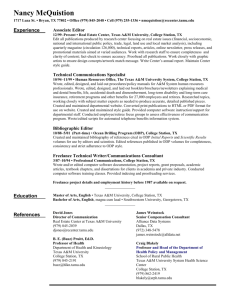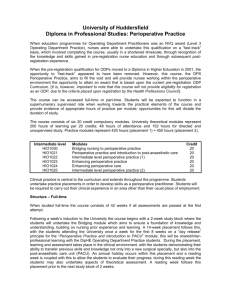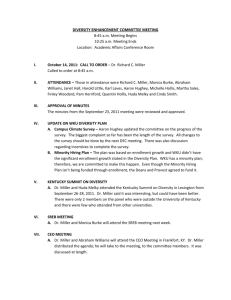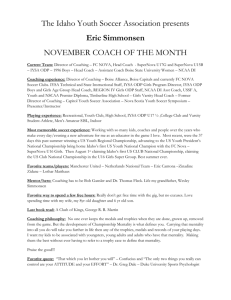Anatomy and Physiology Workbook Academic Year 2010-2011
advertisement
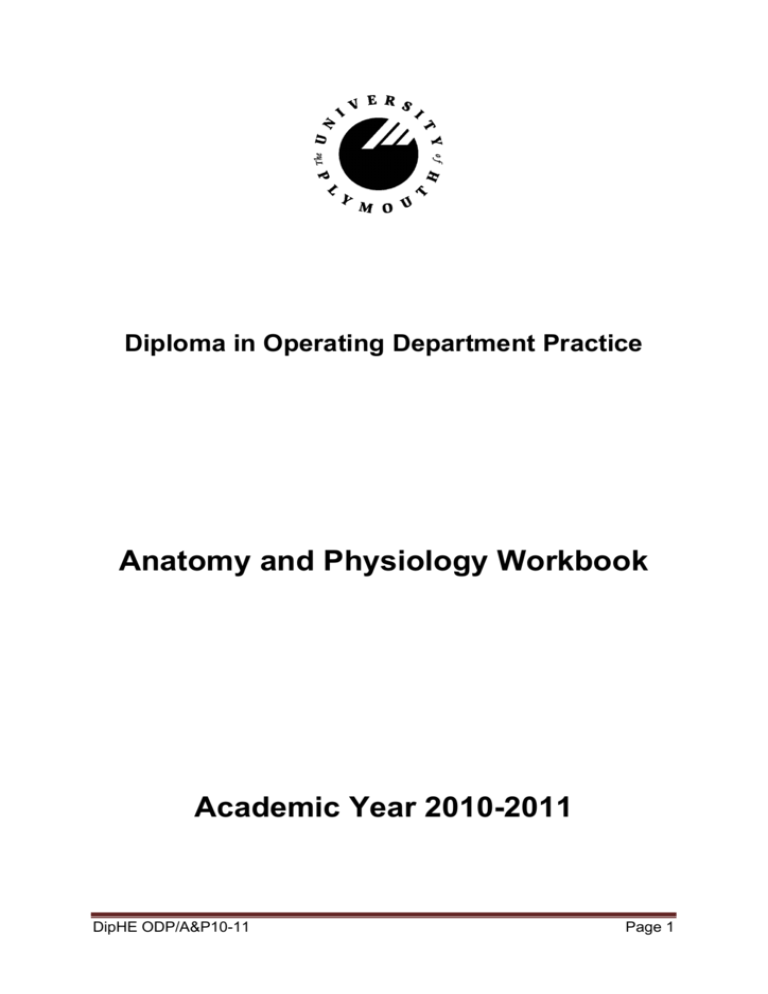
Diploma in Operating Department Practice Anatomy and Physiology Workbook Academic Year 2010-2011 DipHE ODP/A&P10-11 Page 1 Dear Student, This Anatomy & Physiology work book is designed to equip you with the basic knowledge that you will need during the Dip HE Operating Department Practice Programme. As with any work book it is not exhaustive and does not replace extensive reading around your subjects. Module Reference Lists will be helpful in directing you to useful texts and links. This workbook does not form part of the module summative assessment criteria. However, completing it will better equip you to manage the theoretical assessment and your development in clinical practice. Whilst the majority of this workbook will be completed during your private study time you will also be required on occasion to undertake elements during your theory weeks, so it must be brought during this time. In addition, you will have lectures to underpin the knowledge and understanding in each module. The programme team is here to help you with any issues or advice that you may need, please do not hesitate to contact us, Katie Hide Programme Lead DipHE ODP/A&P10-11 Page 2 Index: Section Page Number 1. Cells and Tissues 4 2. Bones and joints 7 3. Blood and the circulatory system 10 4. Respiratory system 14 5. Nervous system 17 6. Digestive system & Accessory Organs 20 7. Endocrine system 25 8. Skin & thermoregulation 27 9. Urinary system 29 10. Reproductive system 31 11. Lymphatic system 34 12. Ear 36 13. Pharynx 37 14. Eye 38 15. Teeth & Jaw 39 Personal Sections: DipHE ODP/A&P10-11 Page 3 Section 1: Cells and Tissues 1. Name the 6 characteristics of cells: 2. What are enzymes? 3. Actual division of the cytoplasm to form two cells is called? 4. What are mitochondria? 5. Lysosomes are produced by the what? 6. Where would you find Simple Squamous Epithelium? 7. Name the types of Fibrous connective tissue 8. Name the types of muscular tissue and provide a brief description of each. DipHE ODP/A&P10-11 Page 4 9. What is muscular tone? 10. Where would you find Schwann cells? 11. Draw and label a neuron to include the following structures: Dendrites Cell Membrane Cell body Nucleus Axon Myelin Sheath Neurilemma Synapse Node of Ranvier Cytoplasm 12. Name three serous membranes. 13. What neuro-transmitter is found in the neuro end plates? DipHE ODP/A&P10-11 Page 5 14. What is the function of tendons? 15. Where would you find Bursae? 16. How does voluntary muscle contract? 17. What muscles move a limb away from the body? 18. Where would you find the sternomastoid muscle? 19. Describe the function of the neuromuscular junction: 20. What is ATP? 21. Define the Superficial Fascia: 22. What is the Deep Fascia? DipHE ODP/A&P10-11 Page 6 Section 2: Bones & Joints 1. The Human skeleton consists of two divisions the ____________ division, which consists of the skull, vertebral column, and the rib cage; and the_________ skeleton, consisting of the bones of the arms and legs along with the bones of the shoulder girdle and pelvic girdle. 2. The ends of a long bone are known as the_____________, while the shaft is called the _________________. 3. An Inflammation of the joints caused by the body’s own antibodies is called ______________ arthritis 4. In fracture repair, a blood clot forms first at the fracture site, followed by an invasion of fibroblasts forming the initial repair structure, the ___________ 5. Prolonged bone degeneration, which results in brittle bones and occurs chiefly in post-menopausal women, is called____________ 6. What is a hinge joint? 7. What is the dense tissue which covers the outer surface of the bone called? 8. What is the term for a depression in the bone? 9. How many bones are there in the human body? DipHE ODP/A&P10-11 Page 7 10. What does yellow bone marrow consist of? 11. What are the diaphysis and epiphysis? 12. What is Cancellous or Trabecular bone? 13. Where would you find discs of fibro cartilage? 14. Where would you find a fixed joint? 15.Name two “ball and socket” joints: 16. Name the joints of the pelvic girdle: 17. What structures are present in the knee joint? 13. What is synovial fluid? 14. What are the functions of the skeleton? DipHE ODP/A&P10-11 Page 8 15. Label the skeleton in Figure 1 Figure 1 DipHE ODP/A&P10-11 Page 9 Section 3: Blood and the circulatory system 1. Fill in the missing words: White blood cells or _______________ can be further divided into ______________ and ________________. The _______________ contains Neutrophils, __________ and ________________. The ______________ contains Monocytes and ________. 2. Fill in the missing words: Red blood cells or (i) _________________ are described as (ii) ___________ (iii) _______________ discs. They are formed in the (iv) _______________ which is present in the ends of (v) ____________ bones and in (vi) _________ and (vii) _________ bones. They have a life span of about (viii) _________ days. Red blood cells contain (ix) ______________ which combine with (x)______________ when blood passes through the lungs.(xi) ________________ a waste product of metabolism is also transported by (xii)__________________________ and this waste product is released during exhalation. 3. What is the function of platelets? 4. What are the two subdivisions of the circulatory system? 5. What is the largest component of whole blood? 6. What are the functions of blood? DipHE ODP/A&P10-11 Page 10 7. What are the layers of the heart called? 8. Label the PQRST complex below and describe the activity in each phase: Complex Description of heart activity P Q R S T DipHE ODP/A&P10-11 Page 11 9. Starting with the SA node describe the conduction pathway of the heart: 10. Draw a cross section of an artery and label: 11. Name the parts of the aorta: 12. Describe portal circulation? 13. What is meant by the term blood pressure? 14. Where would you find the brachiocephalic vein? 15. Label the diagram of the heart at Figure 2 DipHE ODP/A&P10-11 Page 12 Figure 2: A h fA t S i V L ft P l At L ft P l V i V i A ti S Ri ht At i L ft At i Ch d Ri ht V I f i D P ti l V C di A t DipHE ODP/A&P10-11 S ill t Page 13 il ti T M l (M di l Section 4 Respiratory System 1. Label the diagram at Figure 3: Figure 3 DipHE ODP/A&P10-11 Page 14 2. Where would you find the posterior nares? 3. The pharynx is divided into: 4. What are the respiratory functions of the nose? 5. What are the functions of the alveoli? 6. Describe the main muscles used in breathing? 7. Describe inspiration and expiration and include the action of the muscles you have described in Question 6. 8. Define the following terms: Tidal Volume Inspiratory reserve volume Expiratory reserve volume Residual Volume Vital Capacity DipHE ODP/A&P10-11 Page 15 9. Fill in the table for the composition of inspired and expired air: Inspired Air % Expired Air % Oxygen Carbon Dioxide Nitrogen and other gases 10. Describe the layers of the pleura: 11. Where would you find the respiratory rhythm generator? 12. How is respiration regulated? 13. What is surfactant? 14. Where would you find the arytenoid cartilages? DipHE ODP/A&P10-11 Page 16 Section 5 The Nervous System 1. Name the layers of the meninges: 2. What are the components of the autonomic nervous system? 3. When could the protein content of the Cerebro-Spinal Fluid (CSF) be elevated? 4. What are the components of the hindbrain? 5. Which part of the brain is involved in hearing, language and perception? 6. Where is the “respiratory centre” in the brain? 7. Name 5 neuro transmitters? 8. How many spinal nerves are there? DipHE ODP/A&P10-11 Page 17 9. Complete the table below by inserting the names and functions of the cranial nerves: Number I Name Function II III IV V VI VII VIII IX X XI XII 10. Name 4 of the more important branches of the Brachial Plexus Nerve: 11. What does the involuntary nervous system control? 12. What are the two parts of the parasympathetic nervous system called? DipHE ODP/A&P10-11 Page 18 13. Describe the difference between Cholinergic and Adenergic nerve fibres? 13.Label the diagram below: DipHE ODP/A&P10-11 Page 19 Section 6 The Digestive System & Accessory Organs 1. What substance is important in building myelin sheaths? 2. Label the diagram below: 3. What are the functions of the alimentary tract? 4. What are the functions of the stomach? DipHE ODP/A&P10-11 Page 20 5. What is bile? 6. Name the papillae found on the tongue: 7. What is the function of the Parotid glands in digestion? 8. Describe the stages of swallowing: 9. Which nerves control swallowing? 10. Draw and label a diagram of the stomach, including the orifices and layers of the stomach wall: DipHE ODP/A&P10-11 Page 21 11. Name the arterial blood supply to the stomach: 12. Name the enzymes in gastric juice: 13. What is intrinsic factor? 14. Describe the layers of the small intestine. 15. Where is the sigmoid flexure? 16.Which layer of the peritoneum lines the walls of the abdominal cavity? 17. What is the division between the right and left lobes of the liver called? 18. What is the Porta Hepatis? DipHE ODP/A&P10-11 Page 22 19. Name and describe the functions of the liver: Function Description 20. Name the components of the biliary tract: 21. What are the functions of the gall bladder? DipHE ODP/A&P10-11 Page 23 22. Briefly explain the exocrine function of the pancreas: 23. From the diagram below, what do numbers 1, 11, 12 & 4 refer to? 1 11 12 4 = = = = DipHE ODP/A&P10-11 Page 24 Section 7 The Endocrine System 1. List three main steroid substances secreted by the adrenal glands. 2. What is cortisol and what are its functions? 3. Label the diagram below: 4. What is the inactive form of thyroid hormone called? 5. Describe the location of and function of the Parathyroid Glands: DipHE ODP/A&P10-11 Page 25 6. Where are adrenalin and noradrenalin secreted? 7. List the hormones secreted by the Anterior Pituitary Glands: 8. What is the Pineal Gland? 9. What do you understand by the term hormone? 10 What are the types of islets cells found in the pancreas and what do they produce? 11. What does Vasopression do? 12. What is Tetany? DipHE ODP/A&P10-11 Page 26 Section 8 Skin & Thermoregulation 1. Label the diagram below: 2. What is normal body temperature in degrees Celsius? 3. Write the correct word in the space provided: The temperature regulating centre in the _____________ is responsive to the temperature of the circulating blood. The centre affects body temperature through _____________ nervous stimulation of the _____________ glands. The vasomotor centre in the _____________ _____________ controls the DipHE ODP/A&P10-11 Page 27 diameter of the small arteries and arterioles, and they control the amount of blood which circulates in the ___________ in the dermis. The centre is influenced by the temperature of its ____________ ___________ and by ____________ from the Hypothalamus. 4. How is heat produced in the human body? 5. What are the main organs involved in heat production? 6. What are the three layers of a hair? 7. What are the functions of the skin? 8. What is hyperpyrexia? 9. What percentage of circulating volume is contained in skin capillaries? 10. Describe wound healing: DipHE ODP/A&P10-11 Page 28 Section 9 The Urinary System 1. What are shown in the diagram below? 2. What are the 4 main functions of the kidney? 3. Draw and label a renal tubule: DipHE ODP/A&P10-11 Page 29 4. What processes take place in the nephrons to produce urine? 5. What is the detrusor muscle? 6. What are the three sections of the male urethra? 7. What % of cardiac output is received in adult kidneys per minute? 8. How much urine is produced per minute by adult kidneys? 9. What is the minimum volume of urine production needed per day by adults for healthy function? 10. Which sections of the spinal column innervate the ureters? DipHE ODP/A&P10-11 Page 30 Section 10 The Reproductive System 1. How many chromosomes does a human normally have? 2. What is the function of the male reproductive organs? 3. Where is the prostate situated? 4. What is the function of the dartos muscle? 5. Using the diagram below highlight the passage of spermatozoa through the testes to the ductus deferens: 6. What do the interstitial cells of Leydig secrete? DipHE ODP/A&P10-11 Page 31 7. What is the fourchette? 8. Name two differences between the male and female pelvis: 9. Describe the layers of the vaginal wall: 10. What does antiflexion mean in relation to the uterus? 11. Label the diagram below: 12. Describe oogenesis 13. How many phases are there in the menstrual cycle? DipHE ODP/A&P10-11 Page 32 14. What gland is responsible for controlling the production of ovarian hormones? 15. How many lactiferous ducts does each lobule contain? 16.Describe the blood supply to the breasts: 17. What is a morula? 18. What changes occur to the respiratory system during pregnancy? 19. By what % is the circulating plasma increased by approximately during pregnancy? 20. What is the female climacteric? DipHE ODP/A&P10-11 Page 33 Section 11 Lymphatic System 1. What does the lymphatic system consist of? 2. What is the difference between lymph and interstitial fluid? 3. What important cells for protection are found within lymph nodes? 4. Fill in the blanks in the table below: Nodes Cervical Location Region served Axilla lower limbs pelvic viscera Near lumbar vertebrae Mesentery Hepatic Pre-aortic Hilum of lung 5. What are the recesses on the tonsils called? DipHE ODP/A&P10-11 Page 34 6. What is an abscess in the tonsil bed known as? 7. What are the four functions of the spleen? 8. What is the thoracic duct? 9. What is chyle? 10. What is the major function of the thymus? 11. Why are macrophages important? DipHE ODP/A&P10-11 Page 35 Section 12 The ear and hearing 1. List the auditory apparatus: 2. Label the diagram below: 3. What is the function of the Eustachian tube? 4. What function do the semi-circular canals serve? 5. What are the three qualities of sound? 6.Which cranial nerve serves the ear? DipHE ODP/A&P10-11 Page 36 Section 13 The Pharynx 1. Label the diagram below: 2. What is the function of the false vocal cords? 3. What are the respiratory functions of the nose? 4. What are the functions of the larynx? 5. Where do the lobes of the thyroid lie in relation to the larynx? DipHE ODP/A&P10-11 Page 37 Section 14 The Eye 1. What is the lacrimal apparatus? 2. What are the 4 functions of tears? 3. Describe the three layers of the eye: 4. What does the vitreous body do? 5.Using the diagram below, give a summary of the journey that light waves take to the brain: DipHE ODP/A&P10-11 Page 38 Section 15 The Teeth and Jaw 1. Label the following diagrams and note what are the key differences: 2. Where is the infra-orbital foramen? 3. Where is the intermaxillary suture? 4. What does the zygomatic bone articulate with posteriorly? 5. What would leak if the condylar heads are displaced upwards and backwards to enter the mid cranial fossa? DipHE ODP/A&P10-11 Page 39


